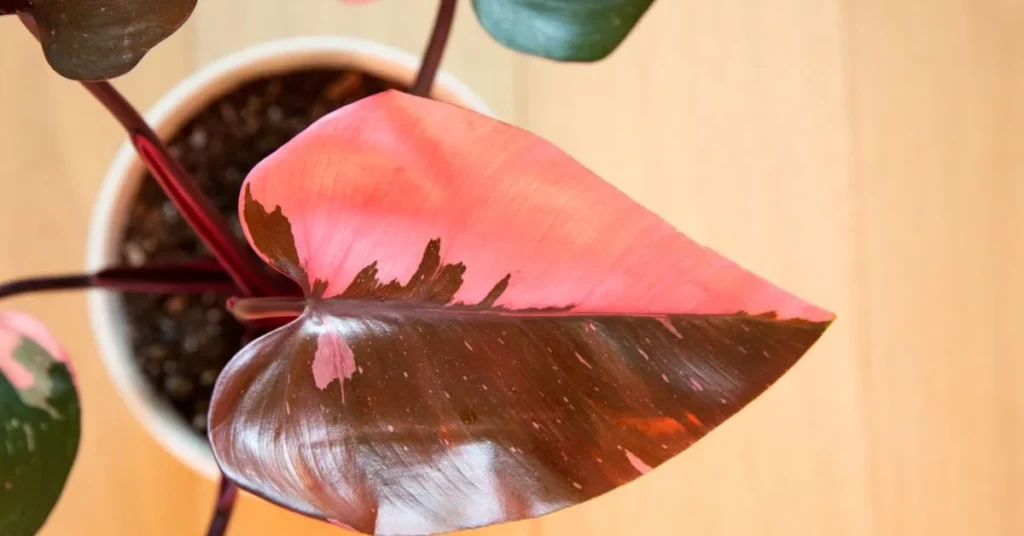
The Pink Princess Philodendron is a true gem among houseplants, prized for its striking dark green leaves adorned with vibrant pink variegation. Caring for this unique plant can be incredibly rewarding, but it also requires specific attention to keep its beauty thriving. In this guide, we’ll cover everything you need to know about caring for your Pink Princess Philodendron, from light and watering to soil and humidity.
What is a Pink Princess Philodendron?
Before diving into care tips, let’s briefly discuss what makes the Pink Princess Philodendron (Philodendron erubescens) so special. This plant is a hybrid variety, known for its stunningly variegated leaves featuring a mix of deep green, blackish hues, and pink. The pink coloration is what gives it the “princess” moniker, and it can range from small streaks to large swaths on the leaves.
Light Requirements for Pink Princess Philodendron
Lighting is one of the most critical factors in maintaining the vibrant variegation of your Pink Princess Philodendron.
- Bright, Indirect Light: This plant thrives in bright, indirect light. Too much direct sunlight can scorch the leaves, while too little light may cause the pink variegation to fade. An ideal spot is near an east-facing window or a few feet away from a bright south-facing window.
- Artificial Light: If you don’t have a bright spot in your home, you can supplement with grow lights. LED grow lights are a fantastic option for indoor growers looking to maintain that beautiful pink color.
Watering Your Pink Princess Philodendron
Watering is a fine balance when it comes to the Pink Princess. Both overwatering and underwatering can cause issues.
- Watering Schedule: Allow the top 1-2 inches of soil to dry out between waterings. This plant doesn’t like to sit in soggy soil, which can lead to root rot. On the other hand, letting it dry out completely may cause the leaves to wilt and lose their variegation.
- Water Quality: It’s important to use distilled or rainwater when watering. Tap water can contain chemicals like chlorine and fluoride, which may harm the plant over time.
Ideal Soil Mix for Pink Princess Philodendron
A well-draining soil mix is essential for the health of your Pink Princess.
- Soil Type: Use a high-quality potting mix that includes perlite, peat moss, and orchid bark. This will ensure proper aeration and drainage, which are crucial for preventing root rot. You can also use a pre-mixed aroid soil for optimal results.
- Repotting: Repot your Pink Princess every 1-2 years or when it becomes root-bound. Spring is the best time to repot, as the plant is actively growing during this season.
Humidity and Temperature Preferences
Like most tropical plants, the Pink Princess Philodendron loves humidity.
- Humidity Levels: Aim for 60-80% humidity to keep your plant happy. If you live in a drier climate, consider using a humidifier or placing a tray of water and pebbles near the plant to raise the humidity levels.
- Temperature: This plant prefers temperatures between 65°F and 85°F (18°C – 29°C). Avoid placing it near cold drafts or heating vents, as sudden temperature changes can stress the plant.
Fertilizing Your Pink Princess Philodendron

Fertilizing is important for maintaining lush, healthy growth, but too much can cause damage.
- Fertilizer Type: Use a balanced, water-soluble fertilizer diluted to half strength. Fertilize once a month during the growing season (spring and summer) and reduce feeding in the fall and winter.
- Avoid Over-fertilization: Over-fertilizing can lead to salt buildup in the soil, causing leaf burn or even damaging the roots. Always follow the package instructions and err on the side of caution.
Pruning and Maintenance
Pruning not only helps maintain the shape of your Pink Princess but also encourages new growth.
- How to Prune: Use sterilized scissors or pruning shears to trim off any yellowing or damaged leaves. You can also prune the plant to control its size or encourage bushier growth. Pinching off new growth can stimulate branching, leading to a fuller plant.
- Propagation: You can propagate the Pink Princess by taking stem cuttings. Make sure each cutting has at least one node, and place it in water or soil to root. Propagation is a great way to expand your collection or share the beauty of this plant with friends!
Common Problems and How to Solve Them
Despite your best efforts, your Pink Princess Philodendron may encounter some problems. Here are a few common issues and how to fix them:
- Yellowing Leaves: This could be a sign of overwatering or poor drainage. Check the soil and adjust your watering schedule accordingly.
- Brown Leaf Edges: Brown tips are usually caused by low humidity or underwatering. Boost the humidity around your plant or adjust your watering routine.
- Fading Pink Variegation: If the pink coloration is fading, your plant may not be getting enough light. Move it to a brighter spot, but avoid direct sunlight.
Final Thoughts
Caring for a Pink Princess Philodendron requires some attention, but with the right environment and care routine, this plant can thrive and continue to amaze with its beautiful foliage. Remember, each plant is unique, and its variegation patterns may change over time. With proper care, you’ll enjoy your Pink Princess Philodendron’s striking pink and green leaves for years to come.
0 Comments